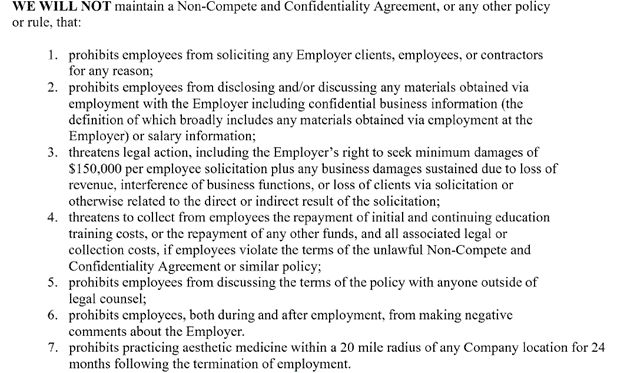The National Labor Relations Board ("NLRB") sent shockwaves through the employment landscape when General Counsel Jennifer Abruzzo took the position that the "proffer, maintenance, and enforcement" of restrictive covenants could violate Section 7 and Section 8(a)(1) of the National Labor Relations Act ("NLRA"). As we previously blogged, the NLRB seemingly took the position that non-competes typically violate Section 8(a)(1) of the Act, which makes it an unfair labor practice for an employer to interfere with an employee's Section 7 rights. We also noted that this theory could wreak havoc on routine employee departure litigation by creating a turf war between the court system and the NLRB.
But a recent memorandum provided by the Division of Advice to a regional office suggests that the NLRB's antagonism towards non-competes may be more limited in practice. The memorandum addressed a fact pattern common to readers. An employee had an agreement with a company that placed restrictions on the employee's ability to solicit or accept business from the company's customers, to disclose confidential information, and to have competitive employment during the term of employment.
The employee then left the company, joined a direct competitor of the company, and began soliciting their former customers. In response, the company filed a lawsuit against the now-former employee, alleging breach of contract, breach of fiduciary duty, and misappropriation of trade secrets. The employee countered by filing a charge with the NLRB attacking the validity of the covenants.
The Region then sought guidance from the Division of Advice on how to handle this challenge. The resulting memorandum is extremely helpful in defining the amorphous policy initial announced by General Counsel Abruzzo. Let's go through the analysis for each provision.
Non-Compete/Non-Solicit Restriction
The employee's agreement included a combination non-solicit/non-acceptance of business covenant. The covenant read as follows:
Employee agrees not to directly or indirectly compete with the Company during the period of employment and for a period of one year thereafter and notwithstanding the cause or reason for termination. The term "not compete" shall mean that the Employee shall not, on Employee's behalf or on behalf of any other party, solicit or seek the business of any customer, client or account of the Company existing during the term of employment and wherein said solicitation involves a product and/or service substantially similar to or competitive with any present or future product and/or service of the Company.
The Division determined that this covenant did not violate the NLRA, because the covenant "does not prevent an employee from accessing other employment opportunities. An employee is free to take a job with a competitor of the Employer's; the employee is only restricted from soliciting the Employer's existing customers in order to provide similar services for a period of one year." The Division reasoned that the employee had not presented evidence that this industry involved a limited pool of customers such that this provision "effectively forecloses other employment opportunities," so the Division concluded this provision did not violate the NLRA.
Here, the Division found this provision did not "prevent an employee from accessing other employment opportunities" because it was limited to a subset of customers. That, in the Division's eyes, meant that the provision could not "reasonably be construed by employees to deny them the ability to quit or change jobs by cutting off their access to other employment opportunities" fitting their skillset and experience—language that matches GC Memo 23-08. But in GC Memo 23-08, the General Counsel framed the test as presumptively invalid unless the provision is "narrowly tailored to special circumstances justifying the infringement on employee rights." Even then, the General Counsel opined that it would be "unlikely" that the employer could provide a sufficient justification for low-wage and middle-wage workers.
By contrast, here, the Division seems to focus on whether the restriction prevents access to other suitable employment opportunities. This appears to be a more permissive formulation that would allow for a restrictive covenant that still enabled "access" to suitable job opportunities.
Takeaway: Employers should formulate restrictive covenants in a manner that does not wholly prevent access to employment opportunities for employees arguably covered by the NLRA. Employers should be particularly wary about "any capacity" agreements, which may be more difficult to justify to both the NLRB and to state courts.
Confidentiality Restriction
The Division next turned to the confidentiality restriction in the agreement, which read as follows:
Employee agrees that during the term of his employment with Employer and thereafter she will not disclose or use any information related to the Employer's business and the business of the Employer's present or prospective customers, including, but not limited to, any promotional concepts, marketing plans, strategies, drawings, customer lists or other information not otherwise made available to the general public. Employee acknowledges that the list of the Employer's present and prospective customers as it may exist from time to time, along with the Employer's promotional concepts, marketing plans, strategies and drawings and are valuable, special and unique proprietary properties of the Employer and constitute a trade secret.
The Division also found that this provision did not violate the NLRA. The Division determined that the provision covered only information that was "clearly proprietary and trade secrets." Unlike other provisions or rules that the NLRB had invalidated, this provision did not reference employee information or information regarding the terms and conditions of employment.
Takeaway: Companies often include a long list of information that qualifies as proprietary or confidential. Companies should review their agreements to assess whether "confidential information" is defined in a manner that could encompass salary information or the employee's working conditions.
Return of Property Restriction
The agreement also included a fairly standard return-of-property provision. The provision required:
Upon termination of employment, Employee agrees to surrender and return to Employer all company property, including but not limited to, drawings, marketing plans, customer lists, company manuals, data, correspondence, keys, files and records. Employee agrees that she will not duplicate or otherwise copy any such property. Thereafter, any mail received by Employee relating to the Employer's business will be immediately forwarded to the Employer.
The Division concluded this provision did not violate the NLRA without much analysis, reasoning only that requiring the return of company property did not implicate information known to employees that may be used in Section 7 activity.
Takeaway: Return of property provisions apparently present little risk to companies.
Best Interests Restriction
The agreement also included a provision preventing the employee from engaging in competitive activity or activity "adverse" to the employer during employment. The provision's exact language was as follows:
Except as hereinafter provided, the Employee shall at all times during the continuance of this AGREEMENT devote her full time to the conduct of the business of the Employer and shall not directly or indirectly, during the term of this AGREEMENT engage in any activity competitive with or adverse to the Corporation's business or welfare whether alone, or as a partner, officer, director, Employee, advisor, agent or investor of any other individual corporation, partnership, joint venture, association, entity or person.
The Division found this provision violated the NLRA in two separate respects. First, by preventing the employee from engaging in activity that was "adverse" to the company, the Division believed that the employee could believe they were restricted from engaging in union organizing or other protected activities. Second, by preventing outside employment, the provision could be read to prohibit employment as a "union salt"—meaning a paid union organizer who accepts employment with a company for the purpose of organizing the workplace.
Takeaway: Companies could still maintain a viable "best interests" provision by having tighter language in the restriction that focuses on employment with companies that sell competing products or services. And, perhaps most notably, the Division implicitly found that one invalid provision in a contract does not invalidate the entire contract. That suggests a contract with a provision that allegedly violates the NLRA is not void but, instead, the unenforceable provision is severed from the rest of the agreement.
The Lawsuit as Potential Retaliation
Finally, the Division determined that the lawsuit filed by the former employer was not preempted because neither of the contractual provisions in the lawsuit ran afoul of the NLRA.
Takeaway: This, in my view, remains one of the greatest areas of uncertainty. Say that the Division found one of the contractual provisions asserted by the employer to be potentially invalid under the NLRA. What then? Would the Board seek an injunction to enjoin the state law proceeding, and would that injunction cover the entire suit or only the claims that were arguably preempted?
Another Settlement Shows the Board Will Take a Harder Line in Settlements
In another blog post, we highlighted what we believed to be one of the first Region complaints challenging a restrictive covenant agreement. On January 29, 2024, the Region reached a settlement with the respondent company. Notably, as part of the settlement agreement, the company agreed to post the following:

The complaint included allegations that, if true, constituted clear violations of the NLRA as interpreted by this Board. Perhaps for that reason, the employer agreed to not prohibit employees from soliciting clients even though a similar—if not more onerous restriction by prohibiting the acceptance of business—was found to not violate the NLRA by the Division in the advice memorandum discussed above.
In sum, the Board still appears to be figuring out the contours of its position on restrictive covenants, but its earliest efforts seem to be focused on provisions where it can draw a direct parallel between already prohibited conduct and the restriction, as well as cases with more clear-cut alleged violations to bolster its efforts to elbow its way into restrictive covenants.
The content of this article is intended to provide a general guide to the subject matter. Specialist advice should be sought about your specific circumstances.

